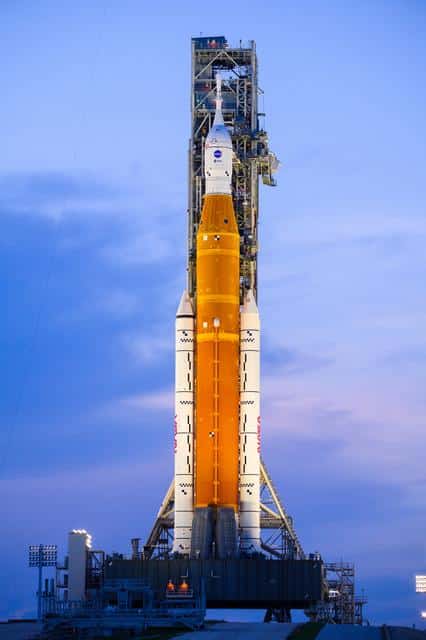NASA plans to try again September 3 to orbit its first new Moon rocket in a half-century, with the Artemis 1 mission set to lift off from Kennedy Space Center during a two-hour afternoon launch window.
The uncrewed launch from the Florida center’s Pad 39B is intended test out the NASA/Boeing Space Launch System (SLS) rocket and human-rated Orion capsule during a planned 37-day mission around the Moon, including re-entry through Earth’s atmosphere and a splashdown somewhere in the Pacific. Among the main goals of the mission are to show that Orion can survive the heat of re-entry and that NASA, working with U.S. Navy teams, can successfully recover the capsule from the sea.
The Artemis effort is aimed at returning Americans to the Moon, landing the first woman and person of color on that satellite, and laying the foundation for crewed missions to Mars. The effort is named after the Greek goddess who was the twin sister of Apollo.
The first launch attempt on August 29 was scrubbed after a faulty sensor indicated that one of the SLS’s four main-stage (or “core-stage”) engines had not been chilled down to its target safe temperature. The chill-down process, using the rocket’s liquid hydrogen fuel, is designed primarily to ensure that bearings in each engine’s multiple high-pressure turbopumps are saturated by cryogenic hydrogen to minus 420F to prevent excessive wear at startup that could lead to an uncontained pump failure and loss of an engine.
That issue, combined with other problems that cropped up during the August 29 countdown and some questionable weather, prompted NASA managers to scrub the launch. In the days that followed, engineers established the one sensor reading was faulty but that five other engine measurements could be used to confirm that the turbopump bearings were sufficiently cold-soaked. That allowed NASA managers to approve September 3’s attempt.
The two-hour launch window opens at 2:17 EDT. In the event of another scrub, additional launch windows are available on September 4, 5, and 6.
NASA last sent astronauts to the moon on its mammoth Saturn V rocket on Apollo 17 nearly 50 years ago, in December 1972. The Saturn V first flew on an uncrewed mission nearly 55 years ago, on November 1967’s Apollo 4.
With its first stage capable of 8.8 million pounds of thrust, the new SLS rocket will be the most powerful vehicle ever launched. By comparison, the Saturn V’s first stage produced 7.5 million pounds of thrust.
A key objective of the SLS’s development, which began in 2011 and, according to The Planetary Society, has cost more than $23 billion, has been to reuse elements of NASA’s space shuttle that had already been paid for by the U.S. government. (That society says NASA has spent more than $20 billion in developing Orion and $5.7 billion more on ground infrastructure.)
The main stage uses four Space Shuttle Main Engines, redesignated RS-25s and upgraded by Aerojet Rocketdyne with new controller computers and an increased thrust capability of 513,000 pounds each. Each RS-25 on the Artemis 1 rocket has helped launch space shuttles numerous times. Engine No. 1, for instance, flew on 12 shuttle missions. The others flew on three to six flights.
Liftoff will be supported by two Northrop Grumman solid-fuel boosters using segments of boosters produced for the shuttle program. Each booster, which use five segments compared to the shuttle’s four, can produce 3.6. million pounds of thrust.
